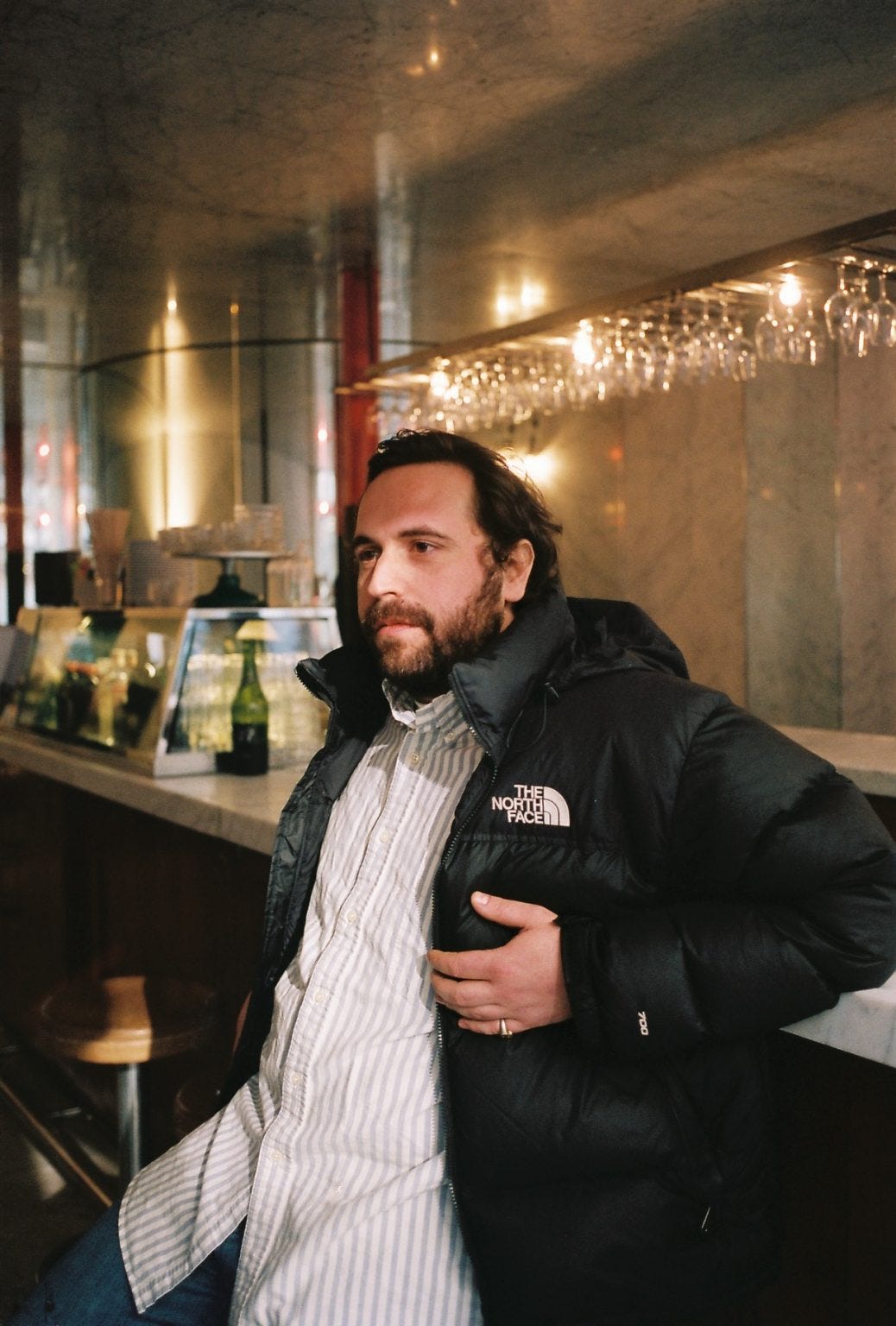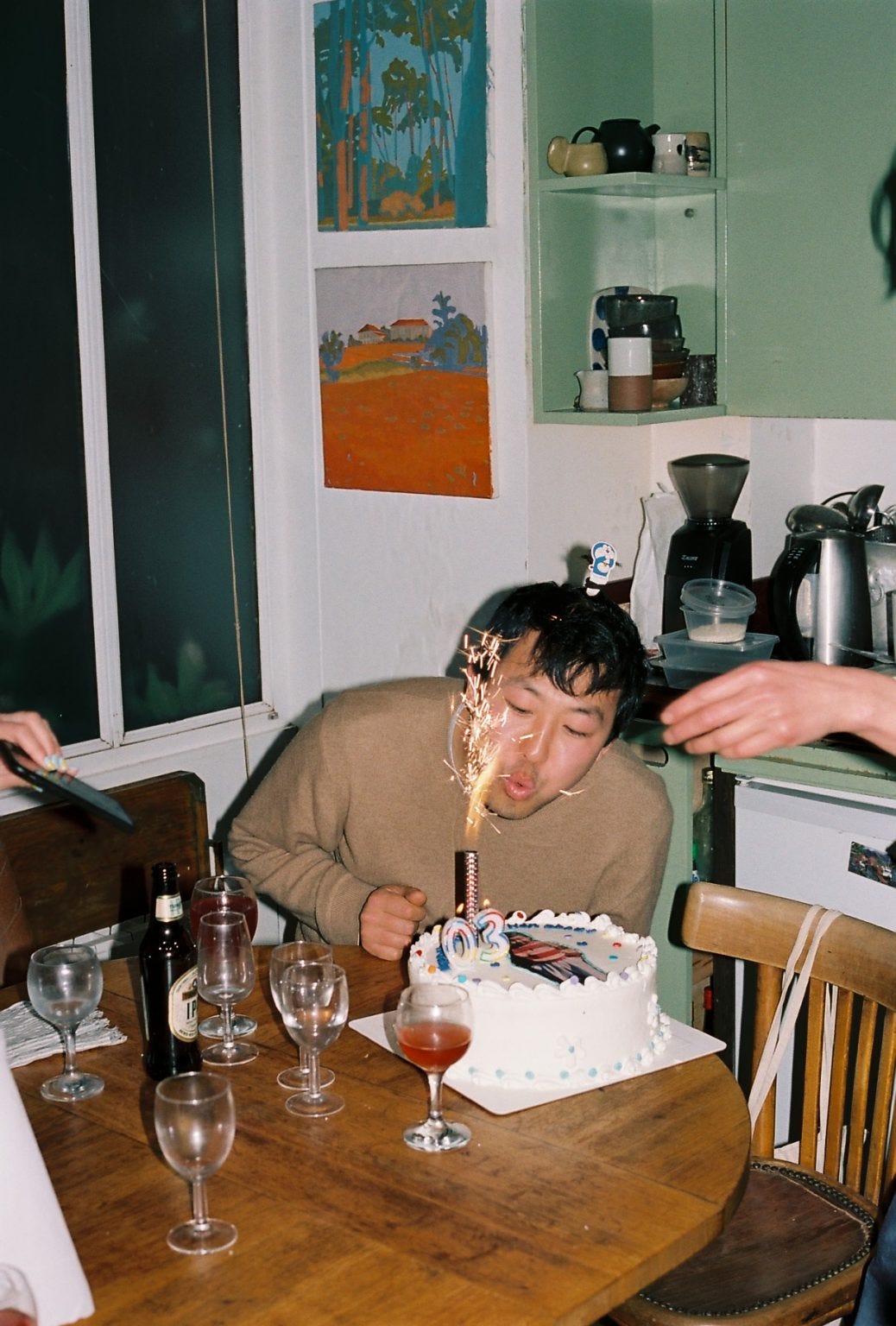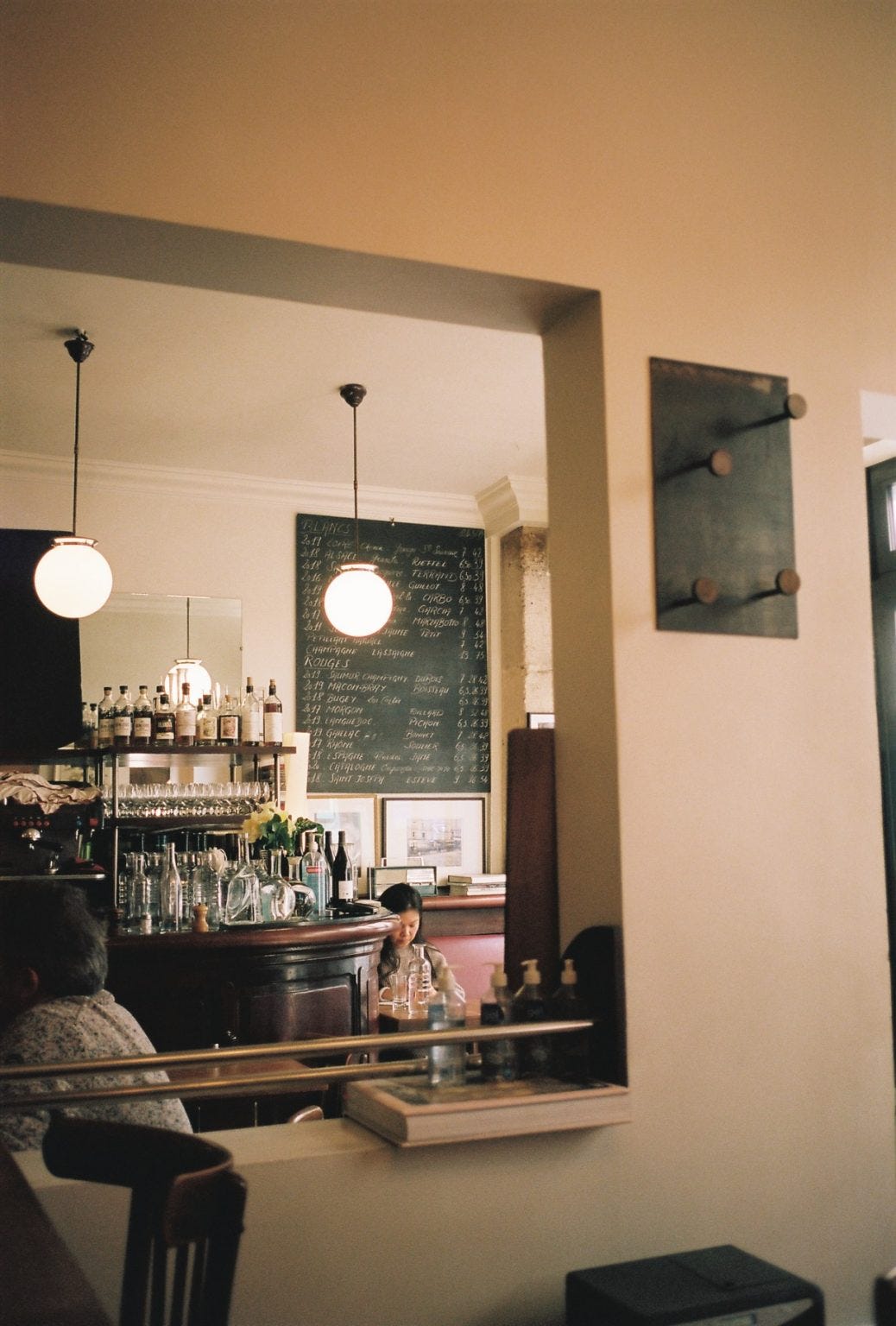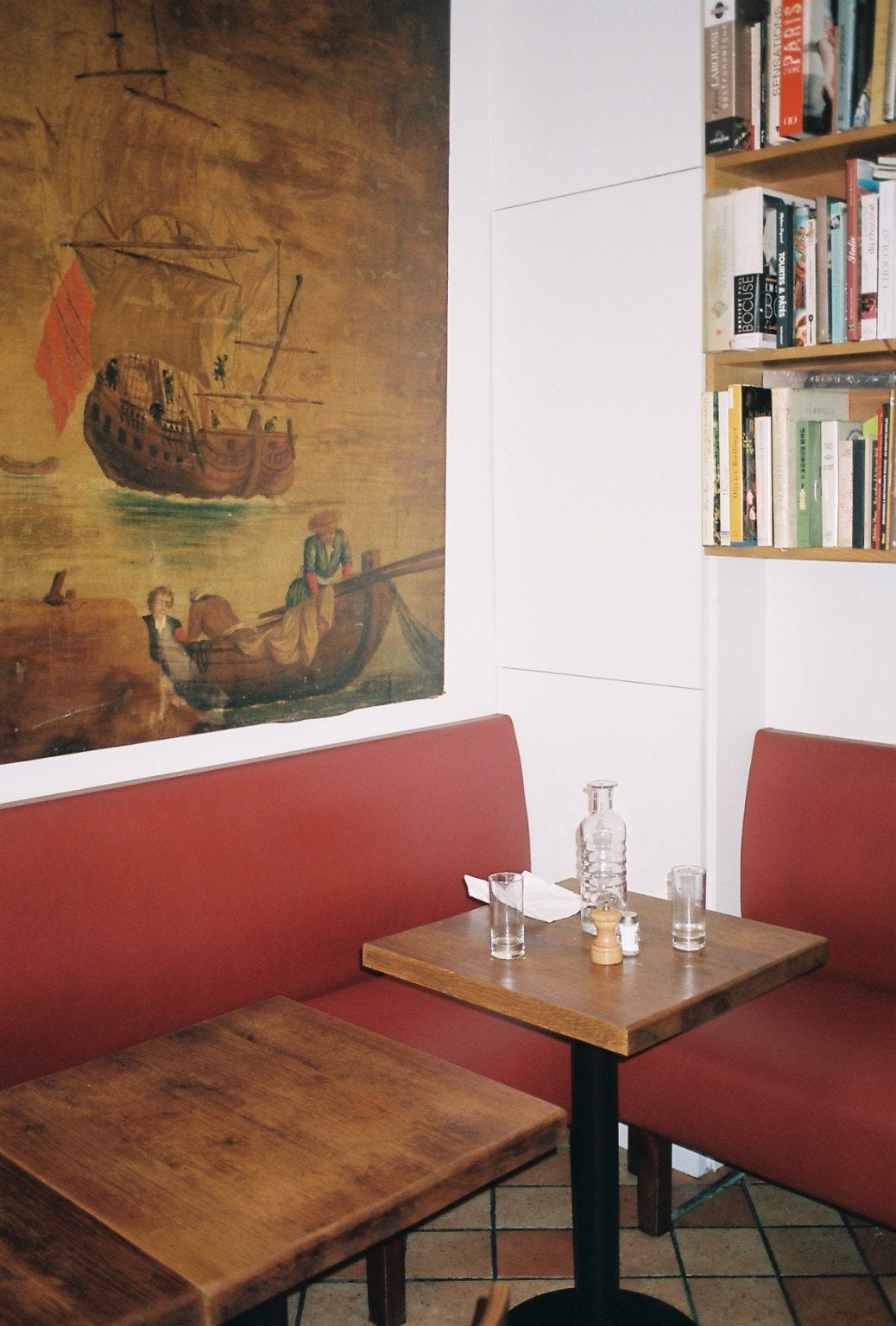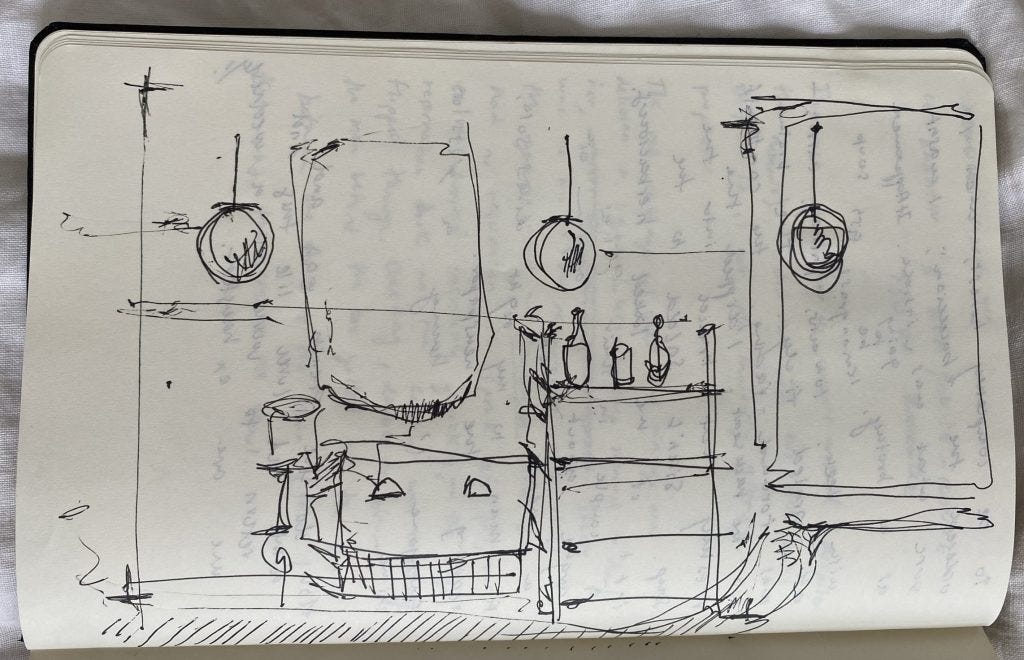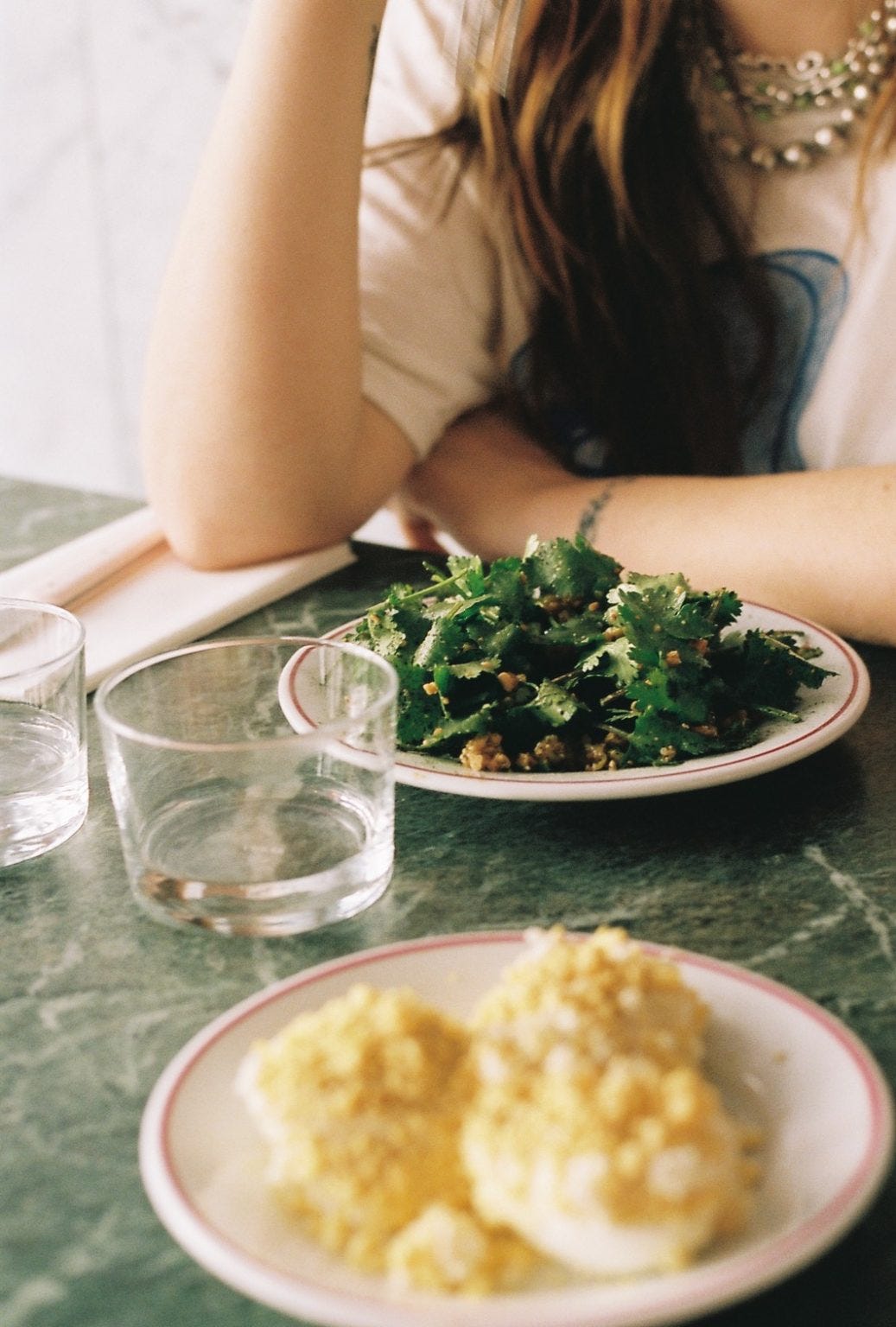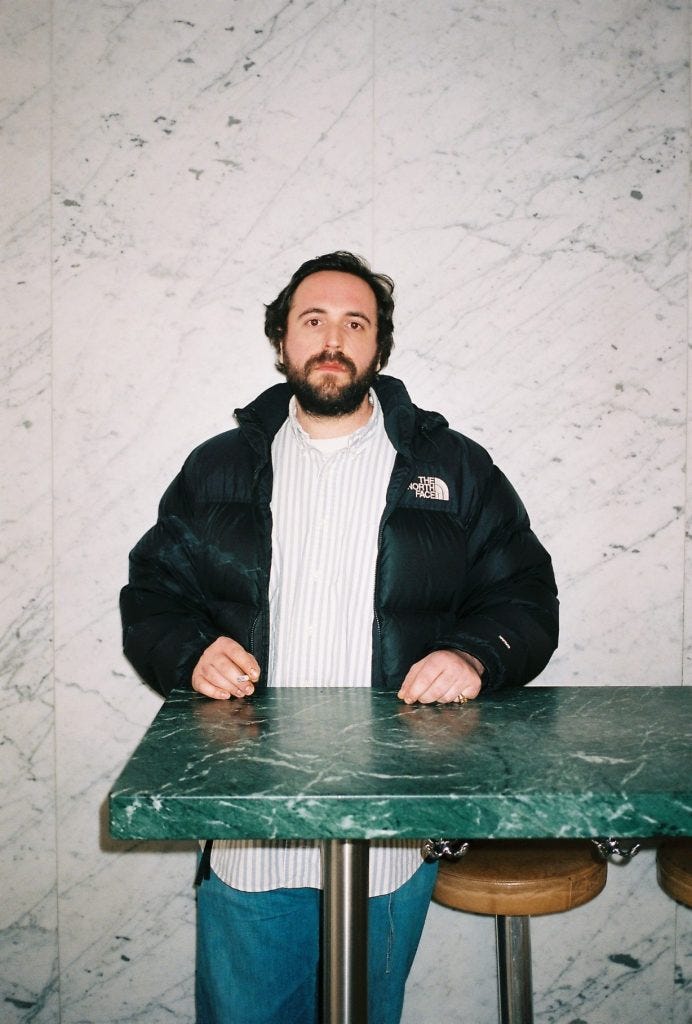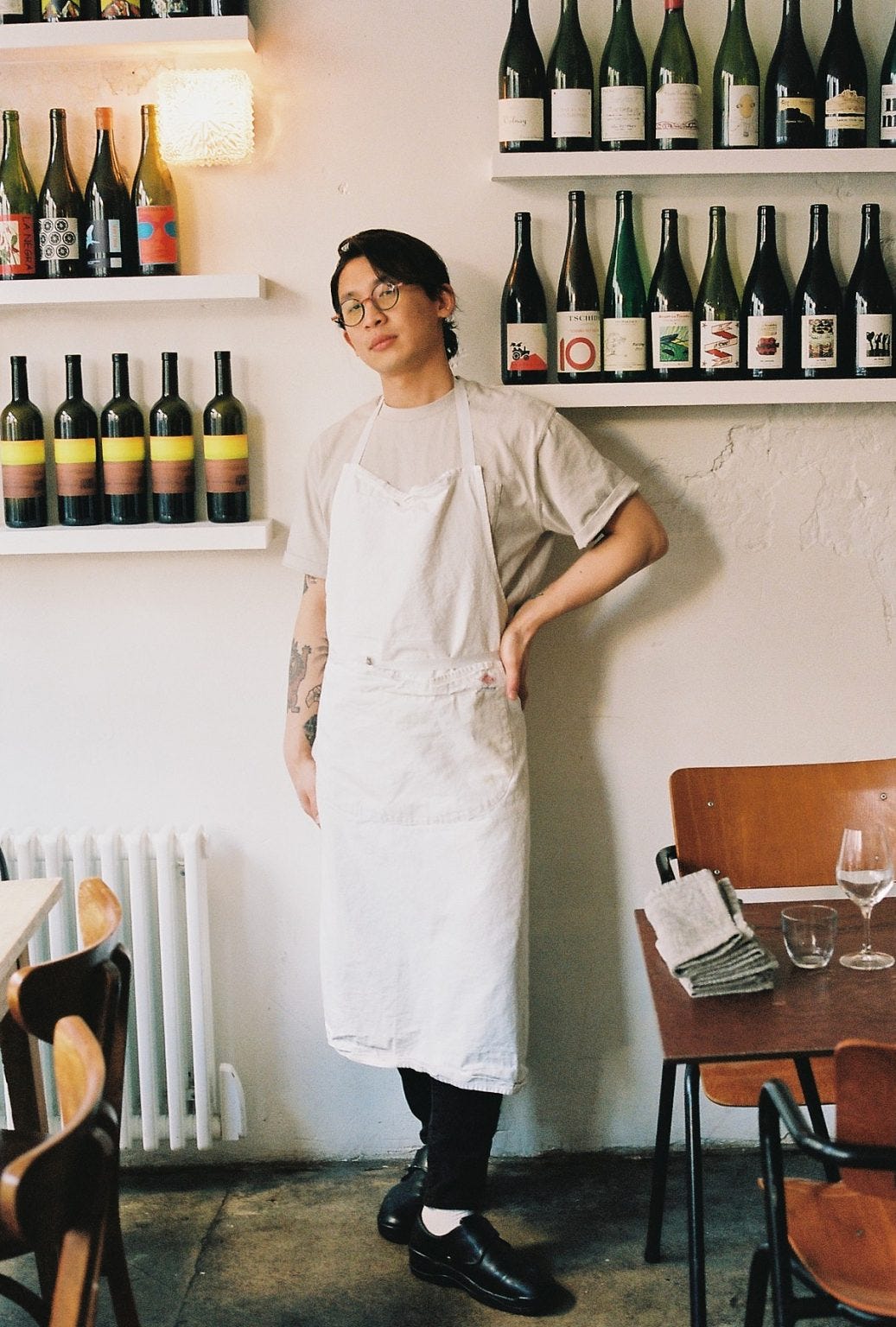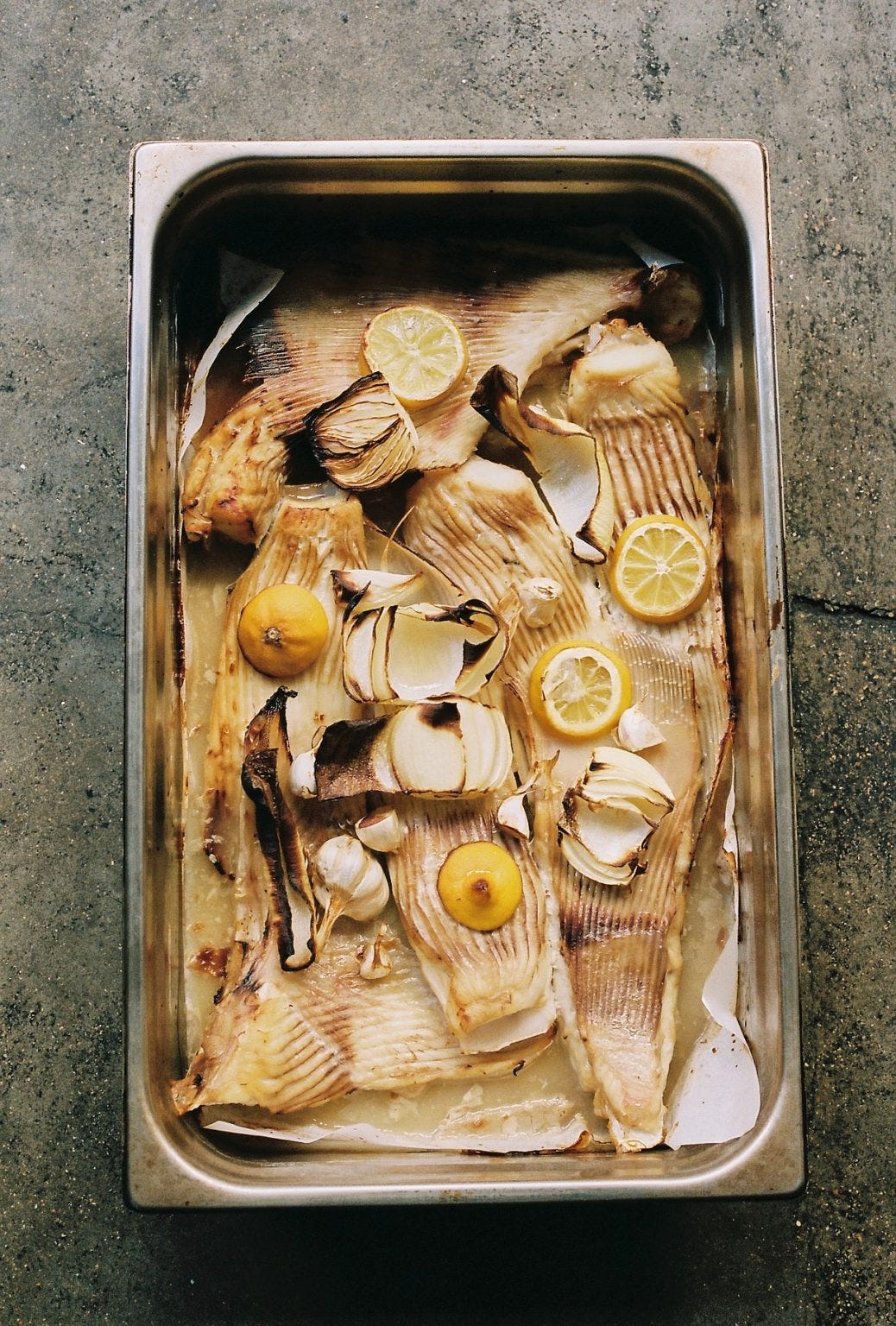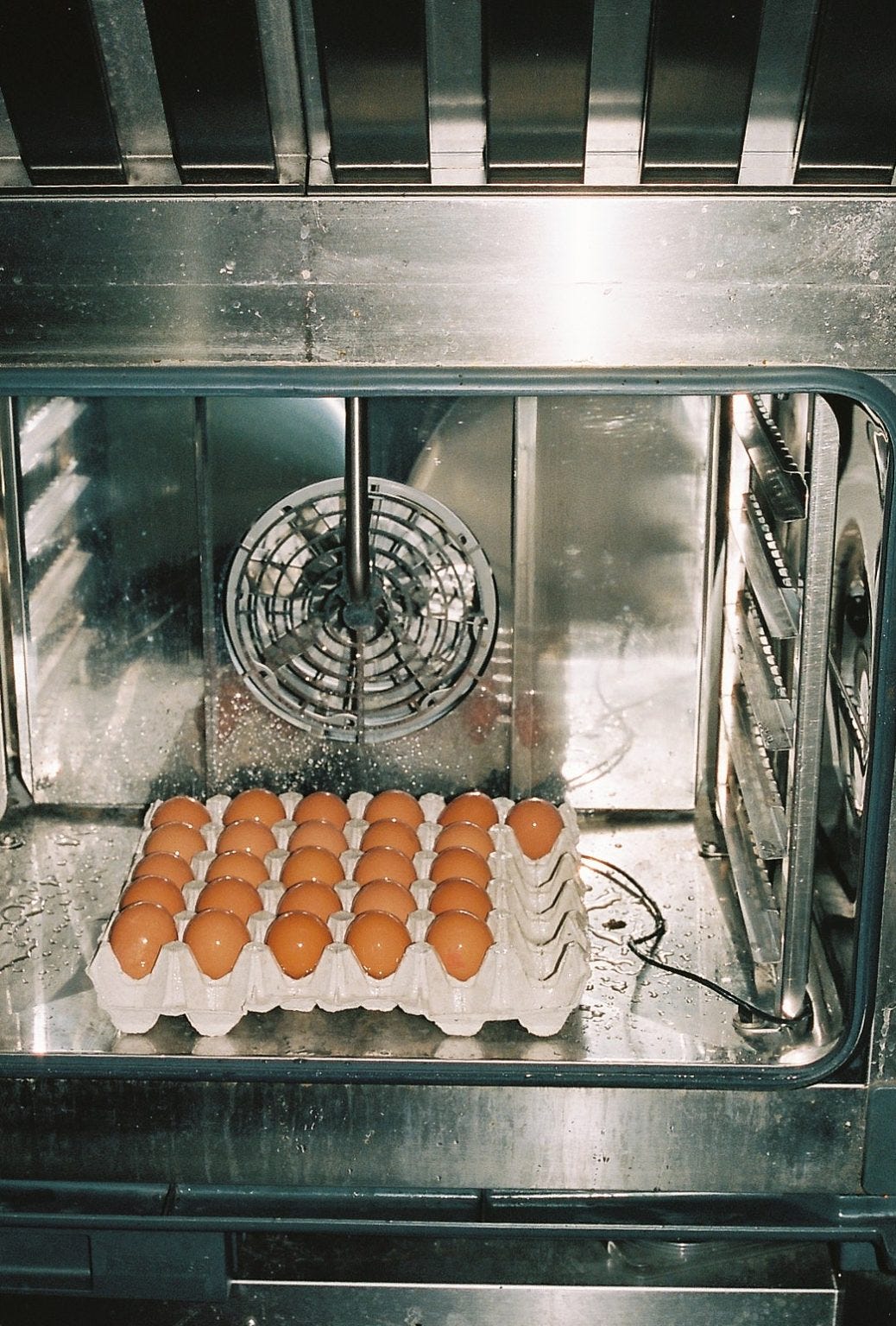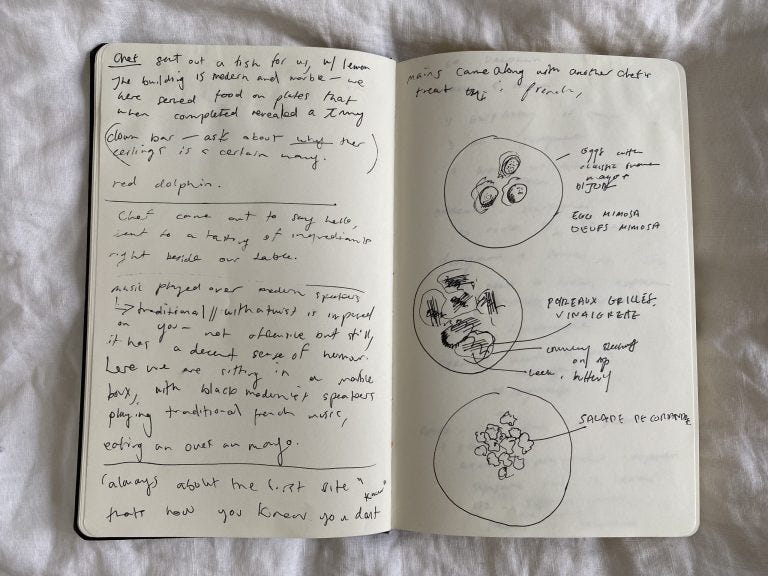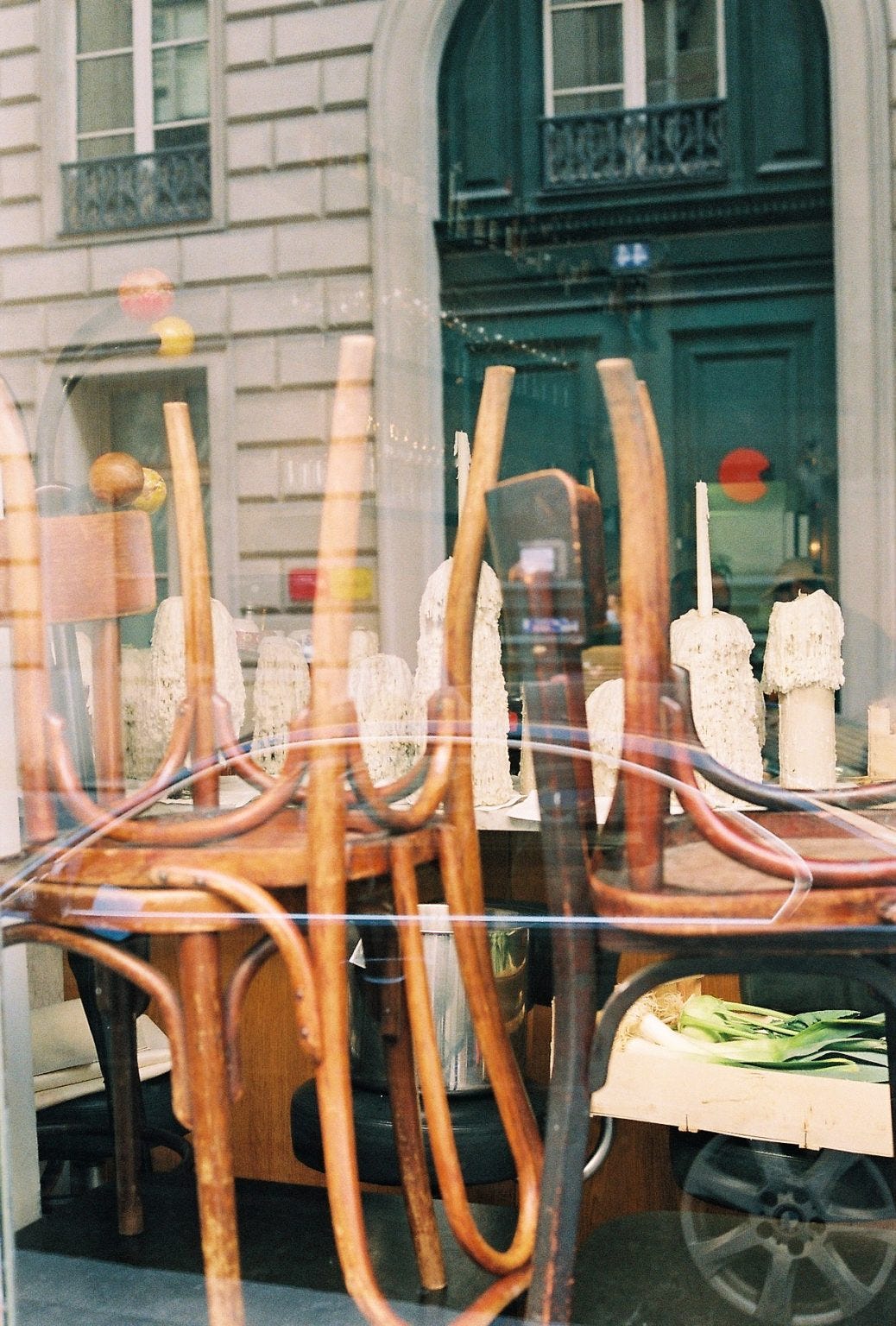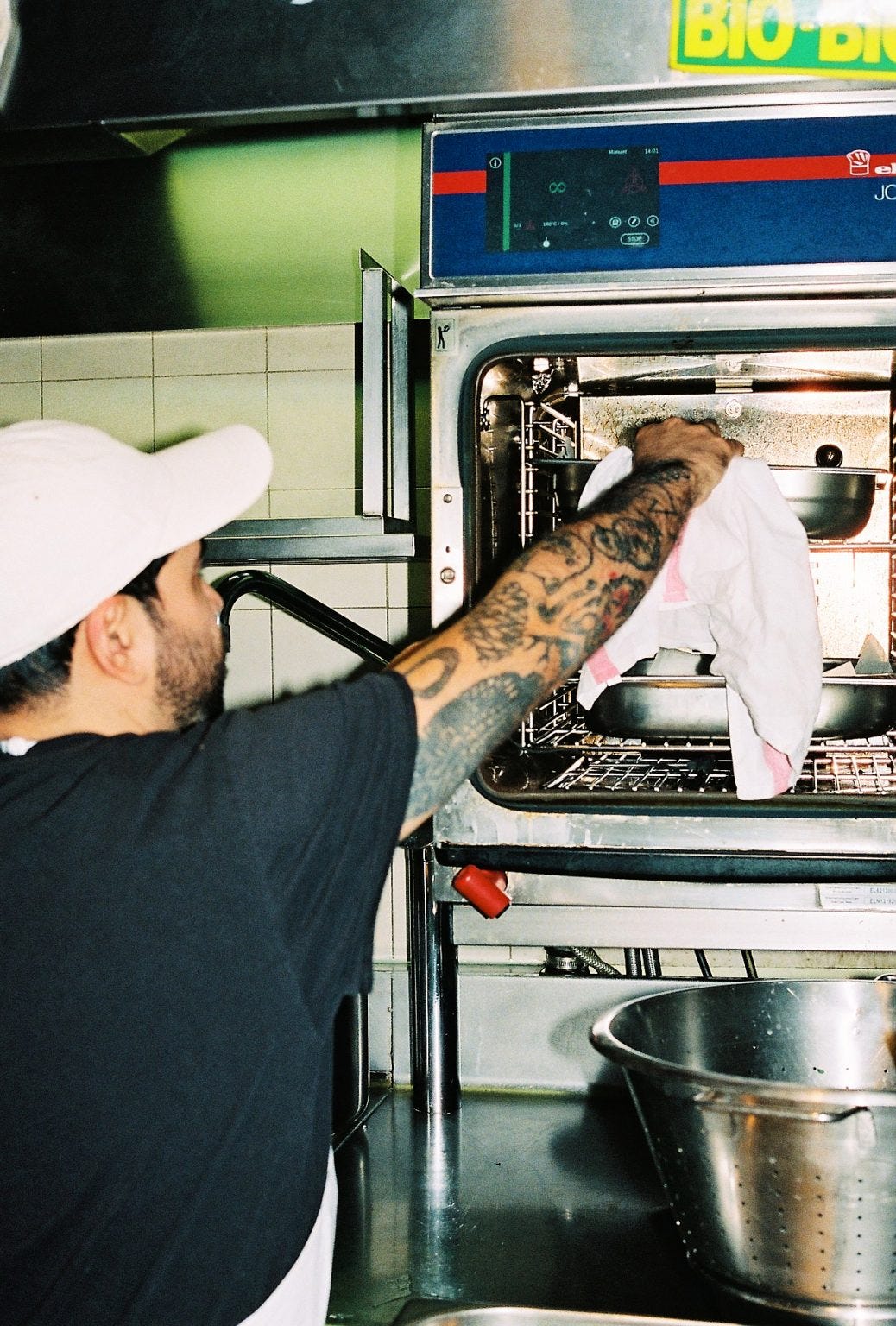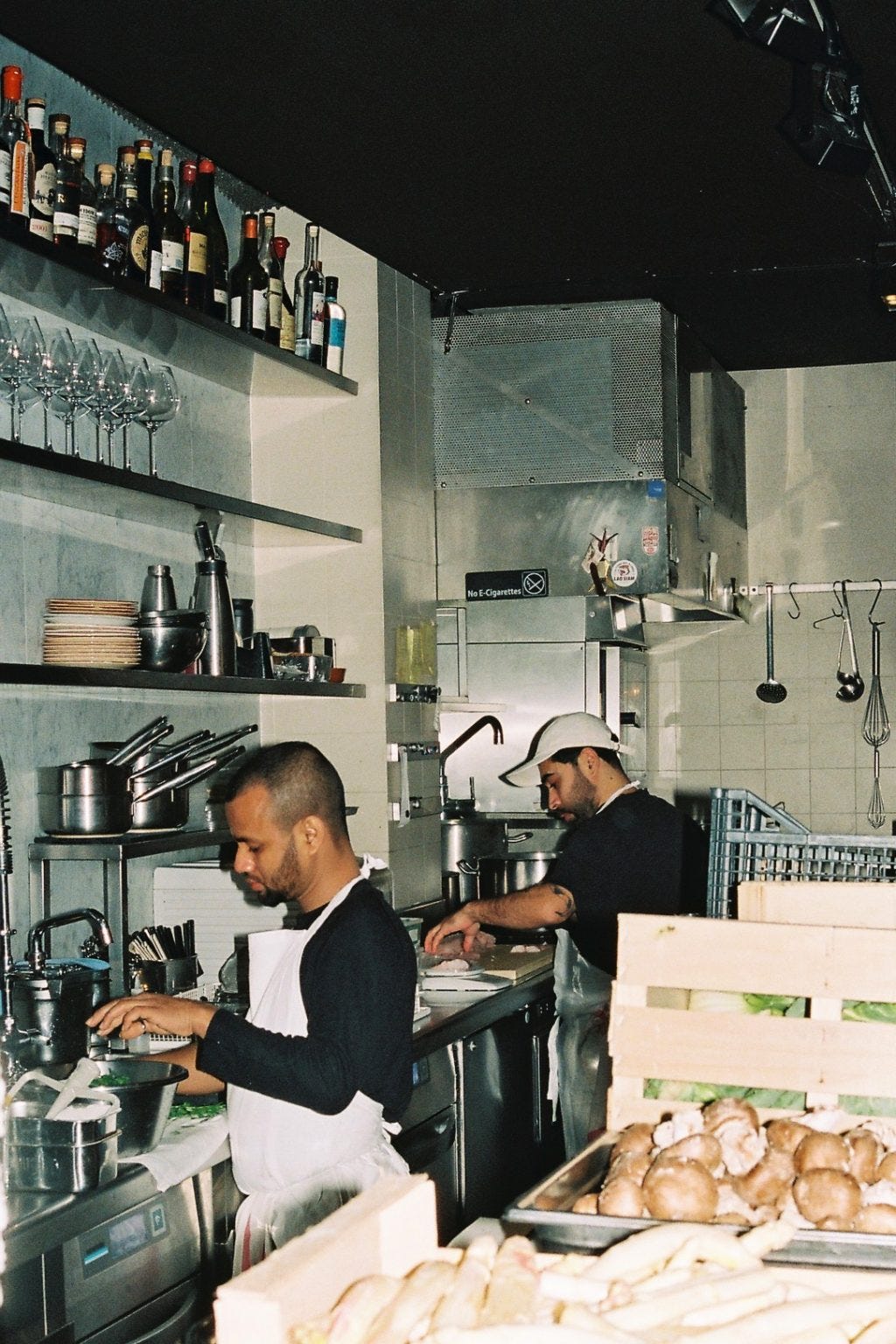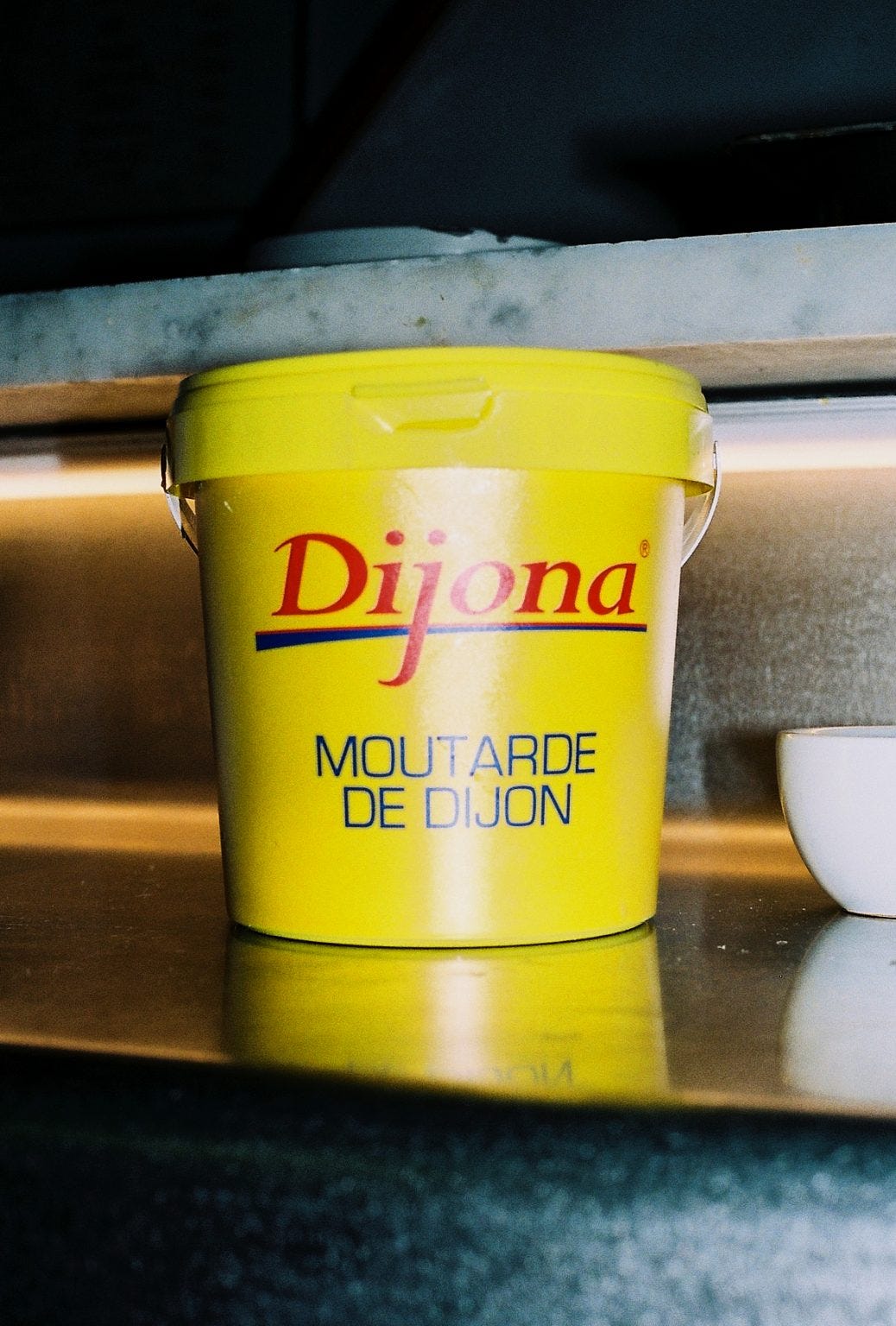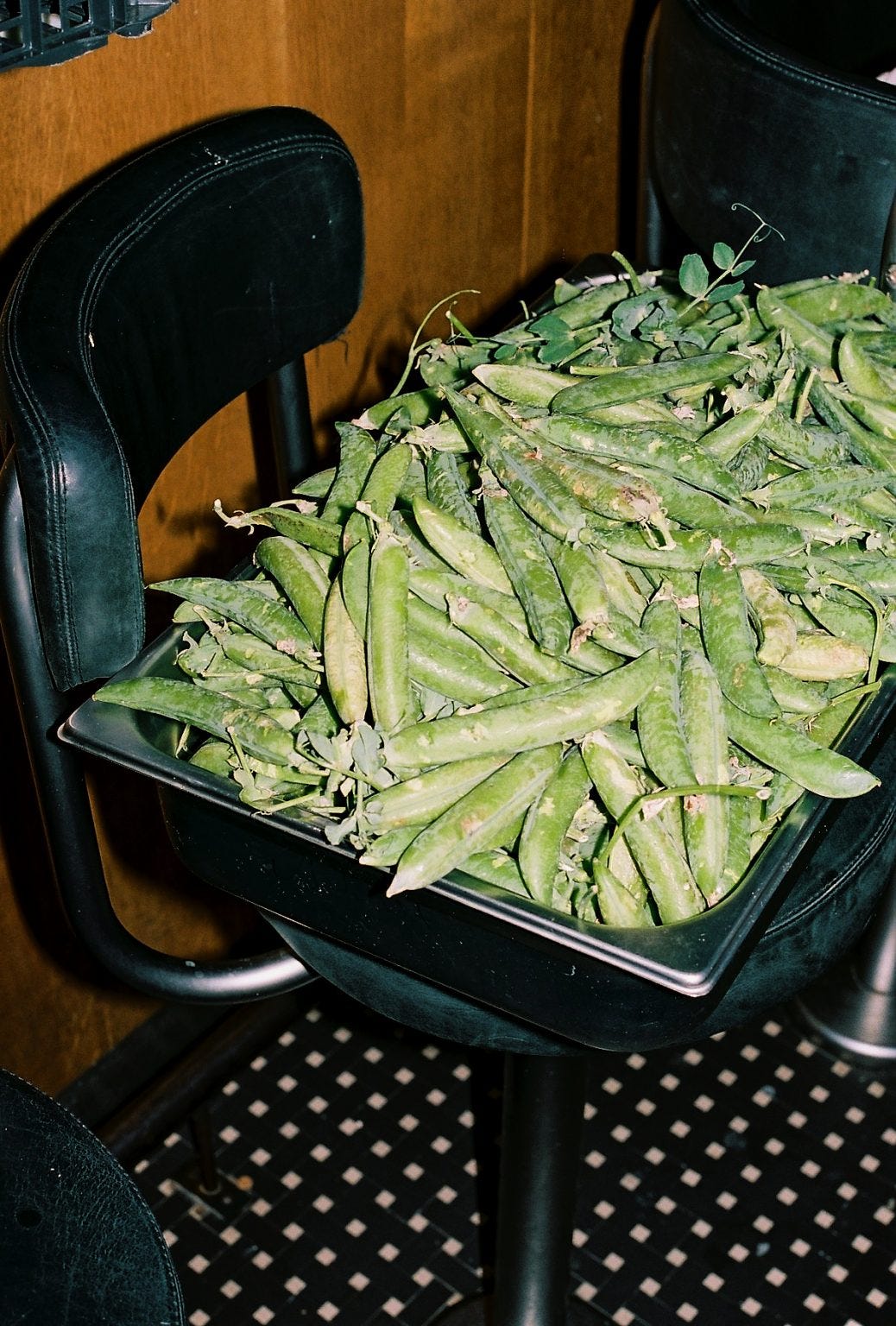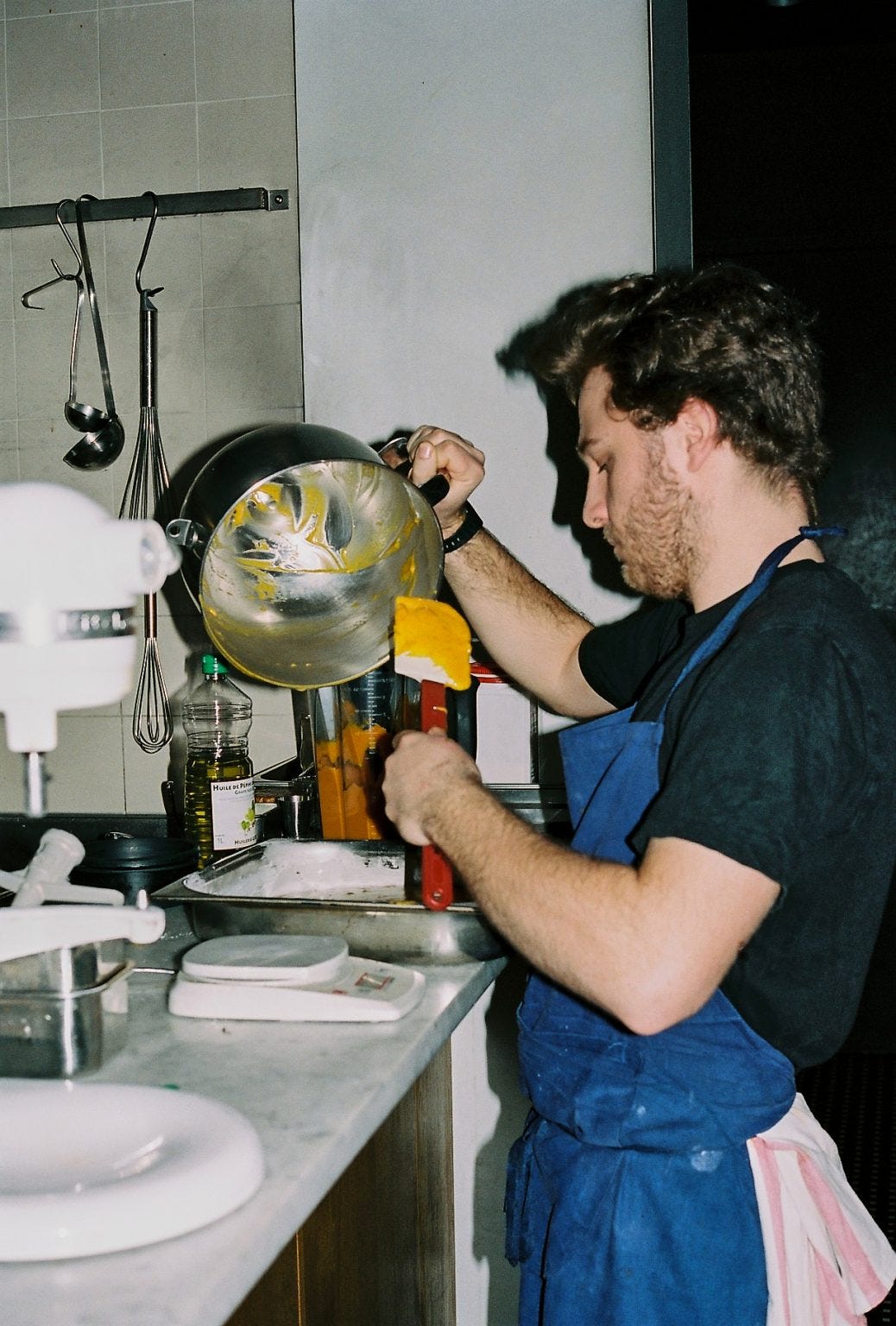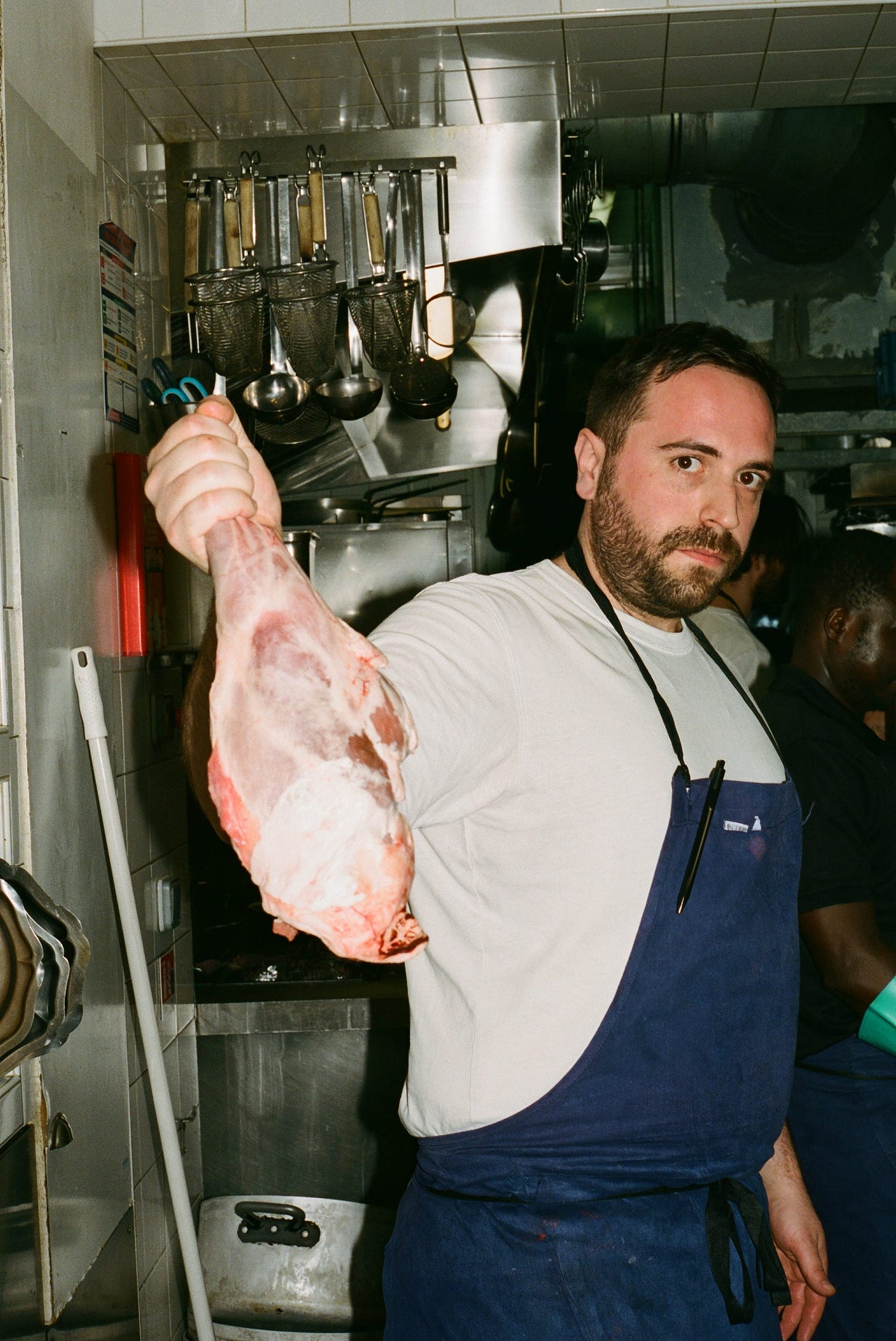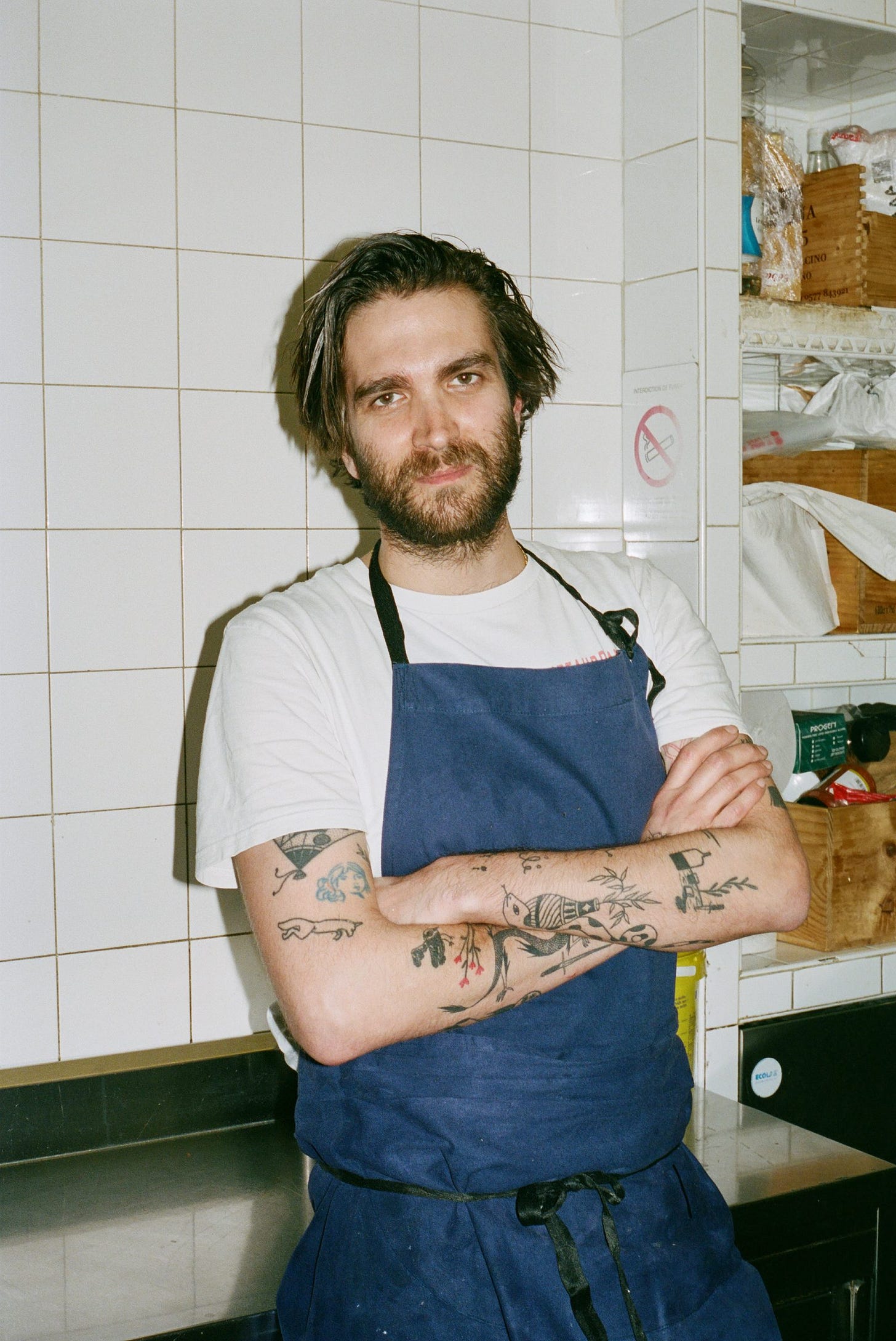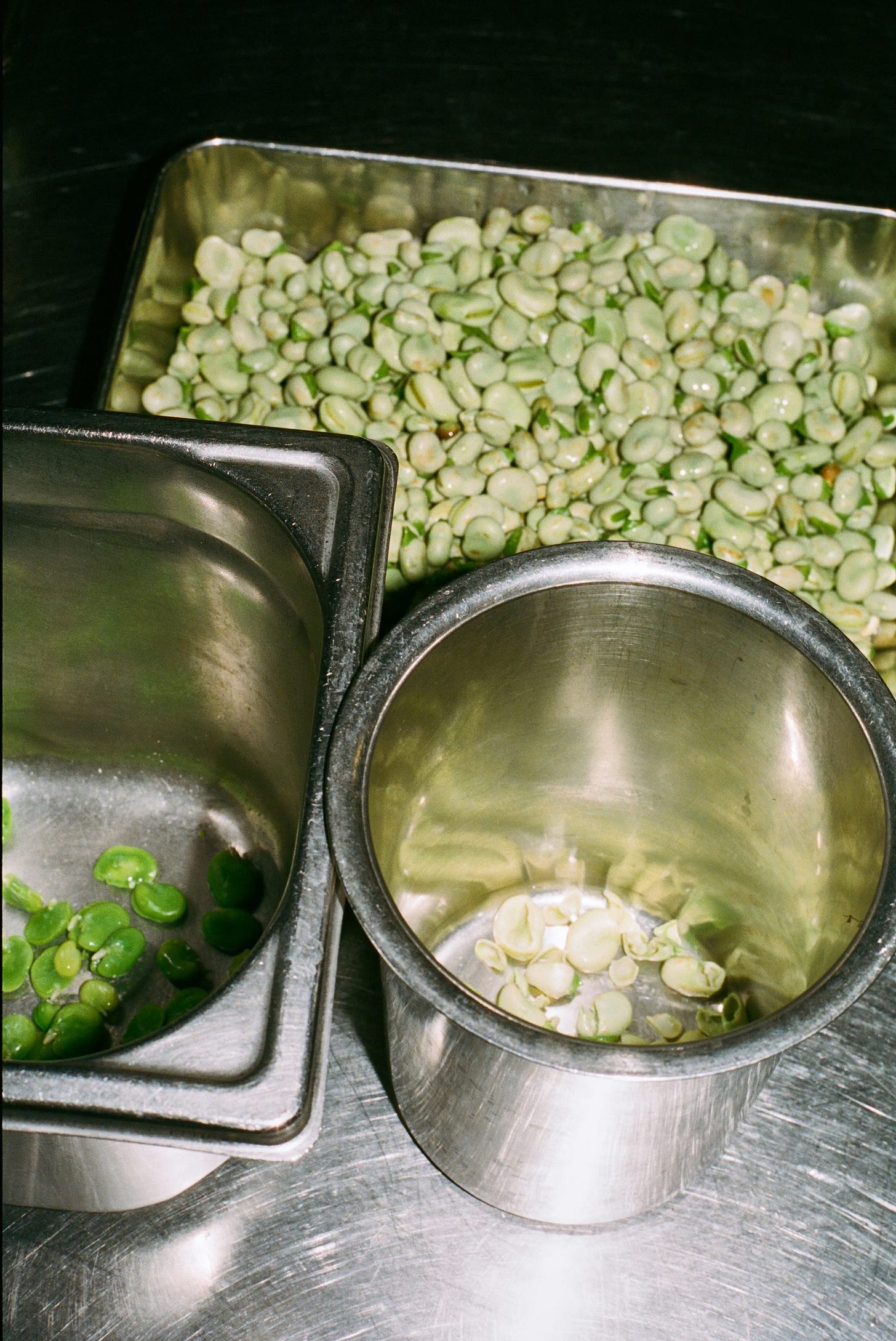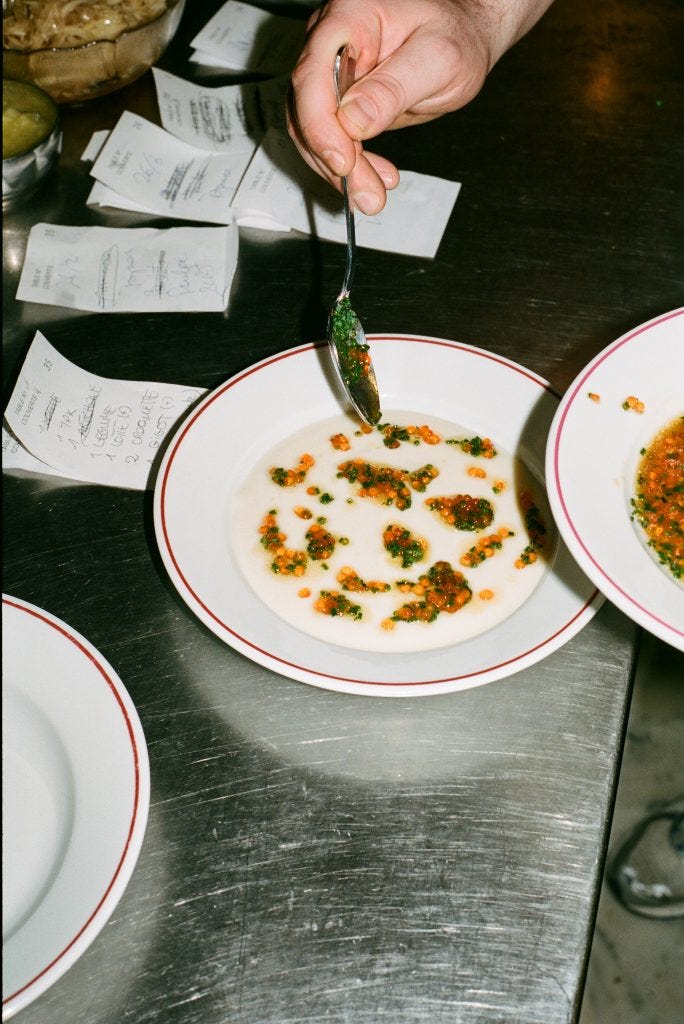Oeufs Mimosa - Food Journals from a Month in Paris
Written by Siân Lathrop & Lucia Bell-Epstein
Photography by Lucia Bell-Epstein
Siân - Sunday, March 6th. 6pm.
We are flying over the Atlantic, on our way to Paris from New York City. It’s the first time we have been since the world shut down in 2020. Over the course of the next month, Lucia and I will interview Chefs, restaurateurs and creatives about their experience in the Paris food scene. What you are reading are excerpts from these travels - snapshots of a month in France.
Our plane food arrives and it is terrible. Lucia’s bread is better than mine so I steal her dinner roll. Off to a good start.
Siân - Monday, March 7th. 2 PM.
We meet up with Simonez Wolf - a stylist and restaurateur from Paris who moved to NYC for 18 years before making his way back to France during the pandemic. Lucien and Mia from STP connected us.
He is about to open a business in Paris, a Banh Mi shop called “Tâm Banh Mi”, named after his mother. The physical space isn’t open yet, so we can’t meet him there (although after hearing what he plans to serve I will most definitely be back as soon as it is open).
Instead, he suggests The Dreaming Man, a third wave coffee shop opened by Yuichiro Sugiyama and his partner Yui Matsuzaki. It’s the antithesis of the classic Parisian sidewalk espresso, the place serves acidic Danish roasted coffee, pour overs and Japanese style patisserie to go. I remark on this as we sit outside waiting for our drinks. Simonez laughs, “Parisians want to walk with their coffees now, not just sit sipping for hours.”
He is right. In recent years the French Bistro/Brasserie has had somewhat of a renaissance in New York. Old haunts have become incredibly trendy once again. Think Lucien on a Friday night, Buvette on a Sunday morning, and Balthazar almost always. In Paris, however, restaurant goers are moving away from the classic French Fare. There’s a NewYorkification of the coffee scene, and the tweezer-style plating found in the highest end restaurants has been interrupted by a new wave of casual, approachable food. Basque style small plates and natural wine reign here.
Simonez has his own opinions on the predominant sharing / tapas style menus. “It's boring.” I am taken aback by his honesty. “Don’t get me wrong, it's cool and I really love some of those places, but at some point it all turned into the same thing.” Simonez has been back in Paris for a little under two years, and craves the food he left behind in New York. He misses the multiculturalism of the scene, and the wide availability of fast casual food.
Simonez plans on serving the classics while also trying out new sandwiches - all while relying on locally sourced and seasonal produce. When we meet him, he's in the midst of deciding on the perfect bread for the sandwich. “I’m looking for something soft, but not too soft.” It’s a delicate balance.
He is a busy man and has places to go, but he leaves us with a few suggestions and we plan to have lunch later in the week.
Siân - Tuesday, March 8th. 7 PM.
Where do most French people eat food? At home. Our first real night in Paris and we decided to stay in for the night and join our hosts, the Mooney family, for a dinner party. It wasn’t just any dinner party, it was Hanzhou Piao’s birthday party. Hanzhou is a chef from Canada by way of Japan and California, and to our great misfortune he isn’t cooking. It's a potluck, and everyone attending brings something.
There is a fantastic selection of natural wine from Cave à Michel, a wine bar just down the street from the Mooney’s apartment in Belleville. People pile in. Unsurprisingly, a lot of the guests at the dinner work in the restaurant industry. It's obvious that the pandemic was tough on restaurant workers. Although there was some government support, many restaurants cut their employees' hours - and people used to working 60 hour weeks were suddenly left with a lot more time on their hands then they were accustomed to. Hanzhou started posting on Instagram, offering to deliver handmade dumplings. It blossomed into a business doing 200+ orders a day, all from Hanzhou’s kitchen.
Delivered on a bike, Hanzhou rode all over Paris. His dumplings caused a sensation. He later explained to us how he did it: “I used Chinese flavors and infused the process with French technique. I would marinate the beef in alcohol before I ground it. I care about flavor. A lot of places don’t care anymore. You stick some ginger in your dumpling and call it a day.” On my last day in Paris we met Hanzhou for a coffee at Mook Café in Belleville, where we interviewed him about the experience of starting a viral business in the pandemic.
Siân - Wednesday, March 9th. 1 PM.
Where do Chefs go to lunch in Paris? It’s a question we asked both Hanzhou and Simonez. A spot they each mentioned was Le Baratin.
If you go at lunch time you can get three amazing courses for 20 euros. A steal. Halfway up the Hill on quiet Rue Jouye-Rouve sits the unassuming spot. There was no one in the restaurant and still the man behind the bar was annoyed that we had no reservation to speak of. Almost in spite of him, our entrees arrived incredibly quickly. The man who served us wasn’t unkind (despite the rumors), I didn’t get his name but I suspect it was not the famously grumpy proprietor. I started with red cabbage, beef and oranges. It was delicious and light.
The large reservation book behind the counter was constantly flipped through. Checking, double checking. A couple in their 90s argued about the origin of a menu item. A man to our right read the newspaper.
Just as our Jetlag hit, our dessert arrived. I ordered a sweet and fluffy country cheesecake topped with fruit and honey. Lucia’s chocolate pot de crème was rich and bitter - incredibly satisfying. Countless books surrounded the alcove we sat in. It was perfect there. Everyone had a glass of wine.
How do the French eat and drink like this, then return to work? We were exhausted. We paid our 20 euros and went to lie in the grass at Buttes Chaumont.
Siân - Thursday, March 10th. 1 PM
Ready to eat, we meet Simonez for lunch on a beautiful Saturday afternoon. All three of us arrive at Le Dauphin, the sister restaurant of the renowned Chateaubriand, around 1:15 PM.
The two restaurants sit beside each other on Ave Parmentier, and are credited with putting the 11th arrondissement on the map. While the Chateaubriand is known for its experimental plates, Le Dauphin does beautifully executed classic French food and wine.
The atmosphere in Le Dauphin is unmatched. The restaurant was designed by Rem Koolhaus, and the space makes a visit to Le Dauphin worth it even before you’ve started eating. The menu is warm and familiar, a contrast to the coldness of the marble interior.
Simonez is friends with Chef Mathieu Canet and has set us up to interview him. We order Oeufs Mimosa to start, and Chef Mathieu sends out grilled fish for us. The menu is deceptively simple, everything is in season. We have a salad of cilantro, a plate of grilled leeks with vinaigrette, and a ricotta and spinach tart. It tastes like spring. For dessert, a twist on the American classic, a banana sundae.
We are served food on plates that, when polished off, reveal a tiny red dolphin. As we eat, I can’t help but laugh. The restaurant seems to wink at itself. We are sitting in a marble box, listening to music playing out of black modernist speakers, and yet here we are eating the most classic French dish you can think of: Oeufs Mimosa. It is fantastic.
The restaurant closes so the kitchen can prepare for the dinner service but we stick around, waiting to speak to the Chef. Suddenly he’s sitting at our table in a big black puffer jacket. He makes everyone espressos and smokes a cigarette. “I am trying to make food that is really legible, very understandable and palatable to everybody.” Chef Mathieu’s philosophy is simple: Good food should be accessible. He emphasizes working with good suppliers and food that is in season: “This week is the start of the asparagus season. So this week we will serve asparagus.”
He moves around the marble box, reaching over the counter for another espresso. “The space is brutal, but that brutality is cut by comforting food. There's no bullshit.” He’s an intimidating figure, tall and bearded, but he moves with grace. His favorite musician is Arthur Russell, the cult figure & disco cellist who died of AIDS in 1992. Russell favored the simple and straightforward - a minimalist with a cello. I am probably reading too much into this, Chef Mathieu isn’t reflecting on why he likes Arthur Russell. He just does.
We sat with him for an hour and spoke in mostly English mixed with a bit of French. Chef Mathieu describes how important it is for him to remove his ego from the food he cooks: “I want to turn away from myself as an individual and learn from the people who came before me. Credit them. The stuff I cook has a lot of references to French classics. If you get the reference that’s cool. But you don’t get the reference from the 200 year old recipe, you can just enjoy your meal. No judgment.” The food and space support Mathieu’s intentions. There is a strong sense of community between the people that work at Le Dauphin, both between front and back of house. It makes sense why there is not much turnaround, most people in the kitchen have worked there for 3 to 5 years.
Chef Mathieu extends an invitation to Lucia to spend a night during service in the kitchen the following week. She takes him up on his offer, which she describes and documents below.
From Lucia’s Journal
Lucia - Sunday, March 20th. 3pm.
After Sian returned to New York, I continued to photograph kitchens and chefs in Paris. There was so much to eat.
I spent an afternoon (that quickly turned into an evening) at Early June, a natural wine bar on Rue Jean Poulmarch. A close friend and my former Chef at LaLou in New York, Jay Wolman, connected me to Camille and Victor, the partners that run Early June. They host traveling chefs from all over the world and Chef Jay will be doing a pop-up from June 8th until July 3rd.
The timing was perfect: it was the last night of guest Chef Esu Lee, who was cooking with his good friend Minh-Tri. I arrived in the afternoon to shoot prep and ended up staying through service to eat at the bar and capture the dinner rush.
Trays of cooked mackerel with lemon and garlic, handmade noodles portioned out for service, delicate cones made of nori and rice, and bright green peas in a waterbath. Attempting to convey the difference in mood, these prep shots are naturally lit and softer than the photos of service that use hard flash to convey the wine bar’s electric energy.
There was a line outside the door before Early June opened for dinner, walks-ins only. The open kitchen allowed me to photograph what was going on without having to be behind closed doors.
Chef Esu’s calm persona and inventive plates matched the warm and welcoming atmosphere, and created an experience that made me feel like I was spending the night with old friends.
Hanging out at the pass, I shot Chef Esu and Minh’s perfect knife skills and his delicate preparation of each dish. There was never a moment of chaos - despite the many order tickets.
I tasted Asian ingredients, flavors I grew up eating in Chinatown with my parents, paired with a classical French palate. The last savory plate, “nouilles au canard avec ail des ours, asperges, et oeuf parfait” was my favorite. Keep an eye out for Chef Esu-Lee and Chef Minh-Tri.
Lucia - Monday, March 21st. 3pm.
Photographer and food creative Andrea Gentl, a close friend from New York, suggested I meet with Robert Mendoza, Chef at Vivant 2. I’ve been working with Andrea on her upcoming cookbook centered around mushrooms, where her knowledge of food, foraging, and photography have widened my palate and visual perspective. Inspired by Andrea's food notes and my mother’s notebooks from my age, I kept a journal during the trip, writing down everything I ate and sketching plates of food and characters.
After having met for lunch earlier in the week, Chef Rob invited me to come spend an afternoon at Vivant 2 before service to hang out, shoot, and see him create a new menu centered around the current spring ingredients available.
Chef Rob’s food is influenced by his Mexican-Californian roots. He warned me that the vibe might switch from relaxed to serious during prep, so I prepared to be (as much as possible) a fly on the wall. As Chef Rob and his small team of two prepared for service, I photographed.
The kitchen is narrow at Vivant 2, and consists of a stove top, small oven, and prep station. A long marble bar extends the length of the restaurant. The vertical, tight space presented an interesting confine, giving both Chef Rob and myself parameters within which to work.
There were boxes of fresh spring produce, just delivered, stacked on stools and the marble countertop. Green and white everywhere– leeks, favas, fennel, various herbs, asparagus, mushrooms, etc.
An octopus boiled away on the stove, while Chef Rob broke down an animal. Mushrooms were being cleaned in the sink and a cake was being mixed on the bar.
Everyone moved in the kitchen with seamless efficiency; the energy was serious but fun, just as I had been prepared for.
Right before service was about to start, Chef Rob and his team finished prep, turned up the music (Britney Spears as a ritual), and ate their family meal. Vivant 2 was about to come alive. I slipped out then. As soon as I return to Paris, I can’t wait to eat here alone at the bar.
Lucia - Thursday, March 24th. 6pm.
I return to Le Dauphin. Loud bass booms from the speakers. The sun is about to go down and the brutalist marble space has taken on a new feeling at night. The restaurant is now lit with pinkish-red lights and it is sexy -- I would come here on a date. Mathieu had remarked during our interview that the atmosphere would be completely different at night and I didn’t understand what he meant until now.
As I made my way into the kitchen, I was greeted by Chef Mathieu, who handed me an apron. He looked different than the week before, his hair was shorter and he was moving fast, ready for service.
Le Dauphin’s kitchen is larger than the other restaurants I visited and the back of house team consisted of four in total. I start shooting each station, going between the hot line and pass. Chef Mathieu offers me tastes– a bite of octopus, a tapioca square, a perfectly grilled sardine– everything I taste reveals a hero ingredient: the main character. Nothing is overly seasoned or disguised. The plates are visually bright, sharp, and elegant.
I help peel a heaping pile of fava beans in between shooting new plates. It feels good to participate in the kitchen and I forget about everything besides the favas and shooting.
Chef Mathieu and his kitchen’s efficient execution is cut with roaring laughter– the jokes are all in French. Everyone is having fun and putting out food that isn’t overly delicate or too fussy. I am able to see what Mathieu describes in his interview, his ethos of making food that is legible and without judgment; food that everyone can enjoy.
Lucia - Tuesday, March 29th. 4pm.
On my last afternoon in Paris, I climbed the stairs to Alice Morieau’s apartment in Belleville. A cook, food stylist, and overall culinary artist, Alice welcomed me into her home; we skipped awkward niceties to immediately start talking about food. Her tone and mannerisms were passionate as she described her infatuation with Algerian pastries, preserved lemon in salads, and her obsession with sheep’s milk yogurt. We spend the next hour going through her pantry and same-day market provisions.
Food for Alice is a ritual. It is just as much about gathering people as it is about the way one organizes their fridge or the lighting that sets a dinner party. She makes a point to tell me her perspective is not spiritual but rather “holistic” and I begin to understand why people are drawn to her food and food curation.
She prefers to eat food that tastes and smells of the ingredients with which it is made. For Alice, “It has to taste like the beast itself…in England, anything lactose is full of flavor and tastes like cow.”
Alice pulls out Bottarga, salted cured fish roe, and tells me about a pasta she makes with it, using olive oil, garlic, raisins and cracked black pepper. She prefers cooking with 3 ingredients, sometimes 4-5, but never more than 6.
I learn about Alice’s love of the artist Mark Rothko, designer Issey Miyake, and American country and reggaeton music. She is a delightful character, thoughtful and effervescent.
Alice purchased a salty ricotta cheese that morning. She pulls it apart with her hands to give me a taste. She brings me onto her balcony, then we sit in her dining room, but spend most of the time in her kitchen. She shows me beautiful plates her mother made with fruits and vegetable designs and her favorite dried oregano from Italy.
On my last morning, I find myself running around Paris sourcing markets and specialty shops for ingredients I tasted from Alice’s pantry, shoving them into my suitcase to give as gifts back in New York.
Lucia - Wednesday, March 30th. 7pm.
On my flight back to New York, I smuggled a lot through customs. Fresh cheese, a small bag of green garlic, a whole loaf of bread, and fleur de sel (salt) from the south. A jar of jam broke in my bag. I miss Paris already.
Lucia Bell-Epstein is a photographer from New York City. She specializes in food and the people who make it, as well as fashion commissions, and portraiture. Her food photography is informed by having worked in restaurants, including LaLou under Jay Wolman and Prune under Ned Baldwin; and for the food photographers Gentl-Hyers. Her work has been published in various magazines, including L'Officiel, Digest, and The Guardian. Lucia is currently shooting a cookbook with a New York based chef to be published in 2023.
Siân Lathrop is a New York based writer, director and producer working in film and television. She is a 2020 recipient of a Canada Council for the Arts grant. Her work has been published by the Canadian Center for Architecture and the Drunken Canal. Her latest short film is set to premiere at TIFF.







